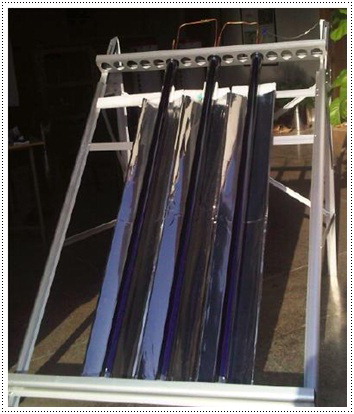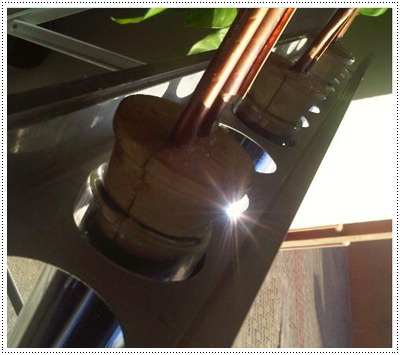Sumathy Krishnan and Samee Khan, North Dakota State University
Nasrullah Khan, COMSATS Institute of Information Technology (CIIT)
Pakistani Funding (HEC): $76,566
US Funding (Department of State): $164,115
Project Dates: November 15, 2010 - November 14, 2012 (Extended through Dec 30, 2013)
Project Overview
This two-year project is intended to show how solar energy can be harnessed effectively and efficiently for heating purposes even in solar-adverse regions like the Gilgit-Baltistan area of northern Pakistan. Given the area’s climate, hot water is an essential commodity during the winter, but low winter temperatures and wind chill remain key limiting factors preventing effective and extensive use of solar energy there. However, recent developments in solar collector technology with CO2 (R-744) as a working fluid suggest potential for utilizing solar energy as a reliable heating source. Therefore, the research team involved in this joint project will work to integrate a solar collector using CO2 as its working fluid with a direct-expansion heat pump to ensure continuous and efficient operation even in harsh subfreezing conditions. The researchers hope that the project will result in a system that will work even in the absence of abundant sunshine and that will be cheap and practical, costing only about $300. With the current energy crisis facing Pakistan, this project will provide an environmentally-friendly alternative for meeting the heating and cooling needs of citizens in the underdeveloped region of Gilgit-Baltistan, lessening their current reliance on the unstable electricity supply or firewood.
Quarterly Update
Experimental testing of the solar CO2 hot water heater models in the U.S. and Pakistan were completed and data from the testing compared with modeling studies. Modeling results indicated the prototype could perform in all seasons including harsh winter weather conditions in North Dakota. However, experimental data showed this model was effective during the spring-summer-fall seasons and during harsh winter conditions required a compressor. To-date, this project resulted in 2 journal publications with 4 additional submitted and 5 conference presentations by the researchers. Educational impacts included development of two courses: a renewable energy technology course (NDSU) and a post-graduate level course in solar power generation (CIIT). Many graduate students worked on this project with three (1 female) at NDSU and two (1 female) at CIIT.
The solar water heating (Thermosyphon) unit containing 6 evacuated glass tubes was fabricated at the NSDU Mechanical Engineering workshop and methods in filling CO2 were studied. Preliminary testing confirmed that CO2 can be a potential candidate for solar water heaters but initial testing was hampered by harsh winter weather conditions in Fargo suggesting that seasonal variation might affect the overall performance requiring further seasonal testing.
Progress Reports
Show all progress summaries | Hide progress summaries
2011 Show summary || Hide summary
U.S. co-principal investigator Dr. Samee Khan visited Pakistan March 31 through April 12, 2011, to familiarize himself with the laboratory facilities of his partners at the COMSATS Institute of Information Technology (CIIT) and discuss plans for the project in detail. This research team initially had trouble finding a manufacturer willing to build a prototype of the system they are designing because the job is technically complex yet small in scale. After the prototype job was rejected by several companies and others quoted exorbitant costs, CIIT managed to manufacture a tube-sheet-type collector at its own workshop. Two videoconference calls were held in mid-May for the Pakistani and U.S. partners to discuss the possibility of manufacturing an evacuated tube collector at the CIIT workshop, a solution that would be both cost-effective and beneficial in giving the workshop’s personnel new opportunities to exercise their technical skills. Taking into account the results of simulation models of the system, the researchers modified the design and agreed that CIIT would build two prototype units, one of which will be shipped to NDSU so testing can proceed in parallel. In the coming months construction of the units will begin and modeling efforts will continue. A review article summarizing various types of solar water heating systems and market trends will also be submitted for publication. Besides the Pakistani PI, the research group at CIIT includes a PhD candidate, a Master’s student, and a research assistant, with two more assistants being recruited. In addition to their research efforts, the partners involved in the project on both sides have also worked hard to attract media attention to their efforts, with articles appearing in three major Pakistani dailies and at least one local newspaper in Gilgit. A press release has been issued by North Dakota State University, and the project has been featured on the Web site Gilgit Baltistan Bulletin. Dr. Khan will also be working to expand his contacts with Pakistani provincial officials in Khyber Pakhtunkhwa to discuss possibly expanding the project to bring solar water heating capabilities to other areas with climate conditions similar to Gilgit Baltistan, including the Swat Valley.
During the fourth quarter of 2011, the research teams from NDSU and CIIT held three videoconferences to exchange progress reports and discuss ongoing work to design and build the water heating unit. CIIT manufactured new components for the prototype unit, including the evacuated glass tube collector and sealed evacuated glass tube with U-shaped heat pipe (see pictures below). Two prototypes of the entire heat-pump assisted water heating system should completed at CIIT by the end of January, with one to be shipped to NDSU so that testing may be carried out by both sides in parallel. A graduate student and two undergraduate students have been recruited to assist with the experimental aspects of the water-heating system at NDSU.
In the coming months, these researchers will be completing work on a joint article summarizing their literature review on the design aspects of the project and will be submitting it for publication. They will also conduct experiments to determine the proper size for the compressor to be used in their system, search for the proper equipment to charge the collector system with R774 working fluid, and continue developing the mathematical model to evaluate the system's performance. Web-conferences will continue to be held to monitor progress on system fabrication and testing. Meanwhile, two conference papers resulting from this project have been accepted and will be presented by NDSU graduate students at the International Conference on Renewable Energy and Power Quality (ICREPQ), to be held in Santiago de Compostela, Spain, March 28-30, 2012.
2012 Show summary || Hide summary
During the last quarter of 2011 and the first quarter of 2012, the research teams from NDSU and CIIT held monthly videoconferences to exchange progress reports and discuss ongoing work to design and build the heat-pump assisted water heating system. CIIT is building two identical prototypes and will ship one to NDSU so that testing can proceed in parallel. So far, CIIT has manufactured new components for the prototypes, including the evacuated glass tube collectors and sealed evacuated glass tubes with U-shaped heat pipe, as no vendors could be found who were able or willing to complete the job. Some problems were encountered with the first two high-pressure pumps for testing the system, which were purchased used on the local market by CIIT. Therefore, NDSU bought a new pump to ship to Pakistan. The team expects that the prototypes will be completed by the end of June 2012. In addition, the design aspects of the system have been reviewed and should be ready to submit for publication in a technical journal by May 2012, and another review paper on solar water heating systems and market trends was submitted to the journal Renewable and Sustainable Energy Reviews in December 2011. Meanwhile, NDSU graduate students Ms. Ruchi Shukla and Mr. Mohammad Raisul Islam (both Pakistani) presented their paper entitled “Performance Improvement of a Heat Pump Assisted Solar Water Heating System” at the International Conference on Renewable Energy and Power Quality (ICREPQ), held in Santiago de Compostela, Spain, March 28-30, 2012. In the coming months, the CIIT and NDSU researchers will continue their work to complete the prototypes and develop numerical models of the systems and their expected performance. Web conferences will continue to be held regularly to monitor progress on both the manufacturing and modeling aspects of the project.
During the spring and summer of 2012, these researchers have subjected their newly designed solar assisted heat pump water heating system to numerical computer modeling. They are currently preparing the results of these simulations for publication in a journal article to be submitted by the fall of 2012. Meanwhile, as of June 2012 they have another paper (“Recent advances in solar water heating systems”) under review by the International Journal of Energy Research Reviews. A conference paper was also submitted to the 11th International Conference on Sustainable Energy Technologies, to be held in Vancouver in September 2012.
 |
 |
| Evacuated Glass Tube Collector (photo courtesy of project team) |
Sealed Evacuated Glass Tube with U Shape Heat Pipe (photo courtesy of project team) |
The U.S. and Pakistani teams have remained in frequent contact via videoconferences to discuss progress made on ongoing experiments at CIIT to test the themosyphon systems and other technical elements of their water heating unit. Various modifications have been made and tested, and a high-pressure pump and solenoid valves have been purchased and shipped to Pakistan to be used in upcoming experiments. CIIT will be building two units and shipping one of them to NDSU for field testing. It should arrive and be installed by the end of September 2012. In addition to their work on the water heating unit, the researchers also plan to design and fabricate another key component of their solar-powered system, a storage tank that can minimize the mixing of hot and cold water.
2013 Show summary || Hide summary
The solar water heating (Thermosyphon) unit containing 6 evacuated glass tubes was fabricated at the NSDU Mechanical Engineering workshop and methods in filling CO2 were studied. Preliminary testing confirmed that CO2 can be a potential candidate for solar water heaters but initial testing was hampered by harsh winter weather conditions in Fargo suggesting that seasonal variation might affect the overall performance requiring further seasonal testing. During a two-week visit to Pakistan in 17-31 December, Prof. Samee U. Khan visited the CIIT counterparts to discuss project progress and future directions that would be undertaken by NDSU. He also gave presentations at the following universities, highlighting the project:
- National University of Computer and Emerging Sciences, Islamabad, Pakistan.
- Ghulam Ishaq Khan Institute of Engineering Sciences and Technology, Topi, Pakistan.
- Quaid-i-Azam University, Islamabad, Pakistan.
- University of Engineering and Technology, Peshawar, Pakistan.
- National University of Sciences and Technology, Islamabad Pakistan.
Although this project was part of the seven chosen for presentation at the First Symposium on Technology Transfer held in Jan 31-Feb 1, Prof. Khan was unable to participate due to a date change caused by unstable security situation in Islamabad. Instead the Pakistani counterpart from CIIT presented project results at the symposium.
The CIIT lab in Pakistan successfully built a prototype consisting of 9-evacuated glass tubes with U-shaped copper heat removal tubes. This system contained all necessary measuring gauges and CO2 filling system and tested under high pressure and temperature conditions.
A review paper was published in early 2013 in Renewable and Sustainable Energy Reviews and one conference paper on this solar water heater was accepted for presentation at the annual American Solar Energy Society conference to be held in late April. Another paper on data from the solar heat pump was submitted to Sustainable Energy Technologies and Assessments and with plans to submit two additional papers for publication.
Back to Pakistan-US Science and Technology Cooperation Program Phase 4 Grants List





